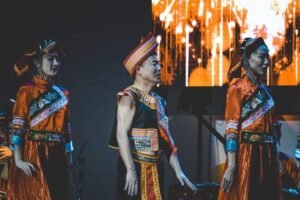At A Coffee & A Story, we believe that every cup of coffee is a window into a culture. But in Taiwan, I discovered that some stories aren’t served in cups — they’re carried in the voices of those who resist. This article is a tribute to Taiwan’s Indigenous tribes and to what their struggle to preserve their identity taught me about the value of roots… even when the world tries to homogenize them like a chain-store coffee.
Endangered Languages: When Coffee Tastes Like Cultural Loss
Years before any other civilization arrived in Taiwan, Austronesian tribes already inhabited the island. They had their own linguistics and genetics, linked to the peoples of Polynesia and the Philippine Islands. Throughout Taiwan’s complicated history, different Indigenous tribes and groups have gradually been homogenized — in various ways, they have been assimilated into Chinese culture and the cultures of other colonial powers (especially the Dutch, Portuguese, French, and Spanish).
Today, 14 tribes are officially recognized and still live in the mountains in small groups. Ethnic minorities in Taiwan speak languages that belong to the Indonesian branch of the Malayo-Polynesian language family. The differences between the various groups and subgroups are so great that, in general, they cannot understand one another.
Like a coffee bean that loses its origin profile when blended with others, Indigenous languages are diluted into Mandarin. But some notes still persist: Amis survives in songs, like the lingering aroma of coffee in an empty cup.
The government estimates that there are about 200,000 people of Amis ethnicity. However, fewer than 10,000 people speak Amis as their first language. The Amis language has appeared in some popular music groups. Other significant Indigenous languages include Atayal, Tao, and Bunun. In addition to these recognized languages, there are between 10 and 12 other Taiwanese Indigenous groups, each with their own languages.

The Impact of Tourism on Indigenous Culture
Despite cultural assimilation and the barriers imposed by modernity, Taiwan’s Indigenous peoples stand strong, preserving their identity against time and homogenization. Their existence is not a relic of the past, but a testament to resilience and adaptation.
These communities have managed to keep their traditions, languages, and worldviews alive — offering knowledge about nature, spirituality, and coexistence that modern society often ignores. Their music, rituals, and stories are not just cultural expressions; they are messages that remind us there are other ways of understanding life, ways that are more connected to the land and to ancestral memory.
In a world that tends to make everything uniform, the richness of Indigenous peoples remains a treasure of diversity. They are not an exotic image or a spectacle for tourism; they are living societies with an invaluable heritage. Learning from them is not just an act of respect — it’s an opportunity to rediscover what it means to belong, to resist, and to coexist with our environment.